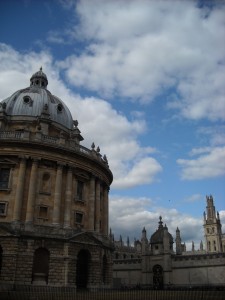
Let’s get a few things straight. First off, Oxford University is not in London. Oxford is in Oxford, approximately 60 miles northwest of the United Kingdom’s capital city. Secondly, there is no “campus”; the University is comprised of over three dozen colleges and private halls which are spread across the aptly named “city of dreaming spires.” Finally, the University was conceived as an institution of higher learning—one of the world’s most prestigious, in fact—and not as a tourist attraction, which may explain why the porters (who guard the entrance to each college) seem more like nightclub bouncers than eager, would-be tour guides.
That said, the city and its many quirks—from the ancient May Day incantations to the fiercely competitive “amateur” regattas— are as British as tea and crumpets. With the 2012 London Olympics just around the corner, Oxford is well worth the trip, especially if you can get past the porters. Part Harry Potter and part medieval fortress, the mecca of British academia deserves at least a day— if not an entire weekend— of your next visit to the UK.
There are numerous guided tours that offer access to some of the university’s more exclusive colleges and libraries, many of which depart from Trinity College, just a few doors down from Blackwells Bookshop, the deceptively “quaint” storefront on Broad Street which actually contains over three miles of book shelves.

If you’d rather explore on your own, head to either New College (founded in 1379 and featured in Harry Potter and the Goblet of Fire) or Christ Church College (founded in 1524 and home to John Locke, John Ruskin and Lewis Carroll) for Evensong. Schedules vary based on church holidays but most evening prayer services, which comprise the Anglican equivalent of the more widely-known vespers, start at 6:00 or 6:15 pm and offer a more intimate view of life within the University.
Having spent a year at New College, I can attest to the fact that there is nothing at all unusual about going directly from Evensong to the pub, and in a city like Oxford there is no shortage of options. Just a few doors down from New College is The Turf Tavern; it’s a bit tricky to find and extremely crowded during peak hours but the thirteenth-century ale house, which features several courtyards, is well worth the hype. For a more relaxed atmosphere, try the Head of the River, which offers a beer garden alongside the Isis just a short walk south from Christ Church.
If you’re feeling truly intrepid, head north to Port Meadow for the hour-long walk to Wolvercote; there you’ll find the ruins of the twelfth-century Godstow Nunnery and the bustling Trout Inn. Built in the seventeenth century, The Trout offers riverside dining along the Thames and features an extensive menu of traditional pub fare in addition to salads, pastas and stone baked pizzas.
Back in the city centre, a £3-ticket to the tower at the University Church of St. Mary the Virgin offers unparalleled views of the city’s impressive skyline including the nearby All Souls College, which was redesigned by architect Nicholas Hawksmoor. From St. Mary’s, it’s just a short walk to the city’s Covered Market, which opened in 1774 and remains a vibrant collection of bakeries, boutiques, grocers, butchers and gift shops. Reward yourself for the 127-step climb at St. Mary’s with a triple chocolate chunk cookie at Ben’s Cookies; they’re huge and sold by weight.
Continuing east, you’ll encounter the charming Sheldonian Theatre, which was designed by Christopher Wren in the late seventeenth century, and the stately Clarendon Building. Together, they comprise one of the city’s most picturesque corners, but Oxford’s architectural marvels don’t end here. The Bridge of Sighs, which spans New College Lane, can be seen from nearby Catte Street and the New College gardens offer an unsurpassed view of the original city wall. Furthermore, the University’s numerous libraries, ranging from the extensive Bodleian Library and the Radcliffe Camera to the newer departmental or “faculty libraries” are well worth a visit.

The city also boasts several world-class museums including The Ashmolean Museum of Art and Archaeology and the Pitt Rivers Museum, which houses the University’s collection of archaeology and anthropology. Most impressive, however, is the neo-Gothic Oxford University Museum of Natural History which contains the University’s zoological, entomological and geological specimens. Inspired by the work of John Ruskin and designed by Thomas Newenham Deane and Benjamin Woodward, the museum features a glass roof and combines both Pre-Raphaelite and scientific design elements.
Like Cambridge, the Oxford school year revolves around three trimesters of eight weeks each, starting with Michaelmas. Given the rivalry between Oxford and “the other school”, it comes as no surprise that the latter trimesters have different names at each of the “Oxbridge” institutions (at Cambridge, they’re called Lent and Easter, respectively, whereas at Oxford, students look forward to Hillary and Trinity).
Despite the “town vs. gown” divide that has plagued the city of Oxford for centuries, it’s not unusual to see dates listed as “Wednesday, 2nd Week, Michaelmas” or “Tuesday of Zero Week, Hillary.” Steer clear of “Negative One Week, Michaelmas” (early October) to avoid grappling with recently arrived study-abroad students and plan carefully for a visit in the spring. The weather is perfect for punting but everyone seems to know this, and with students celebrating the end of their examinations, you’ll have to wade through confetti and champagne corks.
Still, this is the beauty of Oxford. For a university founded nearly one thousand years ago, it’s still very much alive and the “work hard, play hard” attitude of the Oxford undergraduate makes for an enchanting weekend out of London and into the heart of British history.


